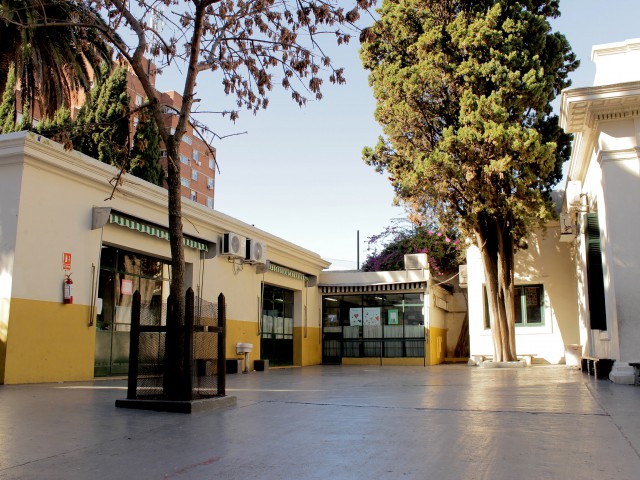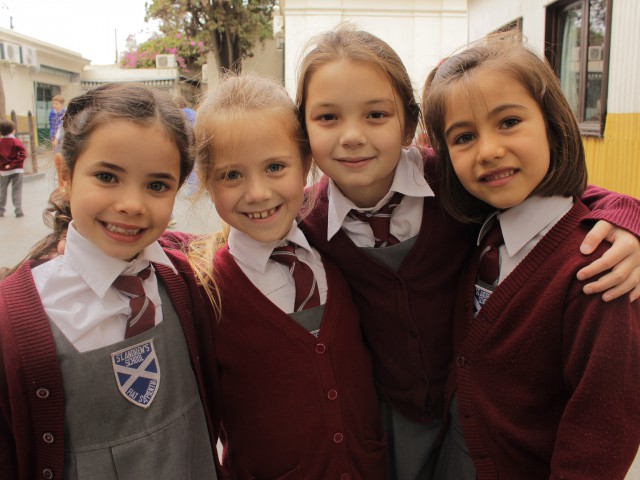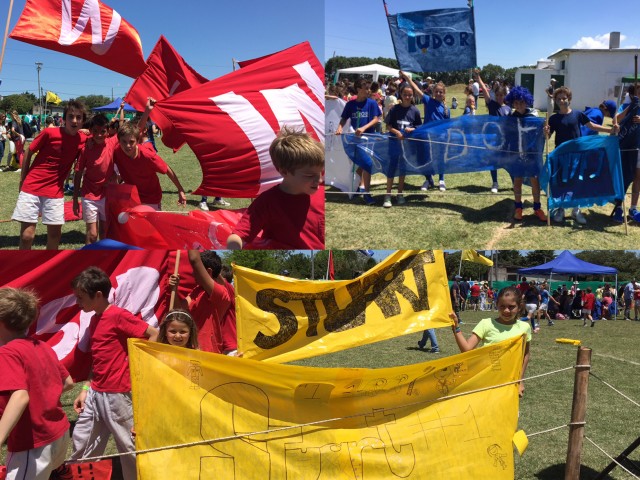Primary
Overview

Primary comprises Form I to Form VI. Pupils start Form I at the age of 7 and finish Form VI at the age of 12.
Class size is an average of twenty, with one Form teacher per group plus several visiting teachers for subjects such as Art, Gym, Singing, Information Technology and Music. The key subject areas in the curriculum are English, Spanish, Mathematics, Science and Social Subjects.
English is the working language throughout the whole school. Pupils are expected to use English at all times except during Spanish and Physical Education lessons. By the time pupils finish Form VI they can read, speak and write fluently in English and are fully prepared to initiate their secondary studies in whichever institution they choose.
Spanish is introduced in the curriculum in Form I and the official programme authorized by the Uruguayan Educational Authorities is applied.
At the end of Form VI students sit for Examen de Egreso which enables them to enter secondary school.
Timetable
Our academic year begins in March and finishes in the month of December. There is a one-week holiday at Easter and then two weeks in July and one in September following what national authorities suggest.
- BEGINNERS: 9:00 to 12:00, Monday to Friday. Every day (optional): 12:00 to 16:30.
- NURSERY: 9:00 to 3:30. Everyday (optional) 9:00 to 4:30
- KINDERGARTEN AND PREPARATORY: 9:00 to 4:30
- FORM I to FORM VI: 9:00 to 4:30.
The School’s timetable caters for a full, well-rounded education with the proper challenge at each stage of development while it allows children to enjoy other activities after school time.
The morning bell rings at 9:00 a.m. sharp, and pupils should be at school as from 8.45. Punctuality is a practice we want to instil in our pupils as latecomers acquire a bad habit from an early age, disrupt lessons and give a poor example. We kindly ask Parents for cooperation in this respect.
Uniforms

Our school uniform is available in Boomerang (Solano García 2525 – Phone: 2712 1451 / 2712 0317) and JP Uniformes (Pablo de María 909 – Phone: 2419 1796)
- BEGINNERS: green overall with Little Learners’ logo. Blue, gym uniform underneath.
- NURSERY: red overall with Little Learners’ logo. Blue, gym uniform underneath.
- KINDER AND PREP: grey uniform to come to school every day except on gym and psychomotricity days, when they come in their blue, gym uniform. Blue overall to be kept at school from Monday to Friday.
- FORM I TO FORM VI: grey uniform to come to school every day except on gym and sports days, when they come in their blue, gym uniform.
Children will start school wearing the summer uniform (polo T-shirt & jumper for girls, polo T-shirt & short trousers for boys) until further notice.
Both grey and gym uniforms are obligatory. All pupils from Form I upwards must have a grey blazer to be worn on cold days and outings. The anorak is to be worn only on rainy days and cannot replace the blazer.
Boys in Forms V and VI may wear long, grey trousers if they wish whereas boys from Kindergarten to Form IV have to wear short trousers except during the winter months when they will be allowed to wear long ones.
Girls must have their hair tied as this will help to prevent the spreading of lice which so worries us all. Hair bands and pins must be burgundy. Girls are not allowed to varnish their nails to come to school.
No jewellery of any kind or “bijouterie”, is allowed as this can be a safety hazard during sports and other activities.
With reference to the gym uniform, the knee-length blue socks and striped rugby and hockey shirts are for competition only.
We specifically ask that all garments as well as lunch boxes and their contents are marked with the pupil’s name. This is of great help when articles are misplaced or left behind.
Our uniforms in detailThe House System

As from Form I the students are divided into three main groups named after one dynasty of British monarchs and are identified by the following colours: Tudor (blue), Stuart (yellow) and Windsor (red). This system is designed to increase student participation in School life, promote positive behaviour and healthy competition.
Bus Service
The company in charge of the School transport is Campotur. For arrangements to make use of this service please contact Ms. Cristina Campolo on 24802270 or 099615069
For organizational reasons on Sports days (Mondays, Wednesdays and Thursdays), parents cannot fetch their children from the sports fields or gymnasium but may authorize the school to leave them at some of the pre-set stops along the bus route back, without cost.
For this purpose you are asked to fill in the corresponding form that you will receive by e-mail. This form must be handed in at the office the very first school day without fail.
A bus service is provided from the school premises at 5:00 p.m. for these children who make regular use of this means of transport.
It is most important that the office is always advised by means of a note whenever pupils who travel regularly by school bus do not make use of the service, or if any changes regarding their usual fetching take place.
Lunch System
Parents can choose from one of the following options for their children’s lunch:
- Dining room: Parents wishing to hire this service should contact Ms Maira on administracion@ble.com.uy or at 097 227 769. It can be hired on a monthly basis or on pre-established, set days.
- Packed Lunch: parents can send a packed lunch which will be heated by staff in charge.
- Home for Lunch: pupils may go home for lunch if accompanied by an adult in charge.
Pupils are not allowed to go out at midday to buy their lunch.
 Español
Español English
English